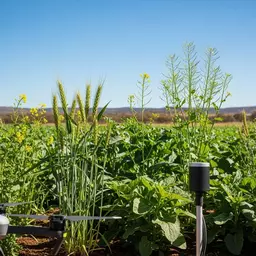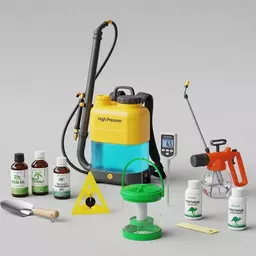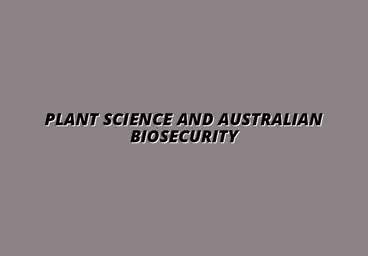Sustainable Pest Control in Australia

As we navigate the complexities of modern agriculture, the adoption of Integrated Pest Management (IPM) emerges as a pivotal strategy for sustainable farming. With its unique blend of methods tailored to Australian ecosystems, IPM not only addresses pest control but also champions environmental stewardship. Curious about how this approach can transform agricultural practices? Let's dive into some key insights!
What You Will Learn
- IPM reduces dependency on chemical pesticides, promoting a safer environment and healthier crops.
- Enhanced biodiversity through IPM practices supports natural predators, fostering robust ecosystems.
- Economic benefits arise from cost savings and increased crop yields, making IPM a sustainable business model.
- Cultural practices like crop rotation and soil health management are vital for effective IPM implementation.
- Ongoing research and education are essential for advancing IPM techniques and enhancing farmer engagement.
IPM Principles and Their Impact
Integrated Pest Management (IPM) is a holistic approach to pest control, combining various strategies to minimize crop damage and promote sustainability. This visual highlights the key principles of IPM and its multifaceted impact on Australian agriculture.
Key Principles of Sustainable Pest Control
-
✓
Monitoring & Identification: Regular assessment of pest populations.
-
✓
Threshold Levels: Determining when control measures are necessary.
-
✓
Preventive Cultural Practices: Crop rotation, proper spacing, nutrient management.
-
✓
Biological Control: Encouraging beneficial insects.
Impact of IPM on Sustainable Agriculture
-
★
Reduced Chemical Dependency: Less reliance on synthetic pesticides.
-
★
Enhanced Biodiversity: Healthier ecosystems supporting beneficial organisms.
-
★
Economic Benefits: Cost savings, higher yields, and access to new markets.
-
★
Improved Crop Resilience: Stronger plants better equipped to withstand pests.
Understanding Integrated Pest Management (IPM) in Australian Agriculture
Integrated Pest Management (IPM) is a holistic approach to managing pests that combines various strategies and practices to minimize damage to crops while promoting sustainable agriculture. In Australia, where diverse ecosystems and unique agricultural challenges exist, IPM plays a crucial role in maintaining the health of our farms and the environment. By understanding the intricacies of IPM, farmers can enhance their production methods and reduce their reliance on harmful chemicals. This approach aligns with the goals outlined in reports such as the CISS Impact Report, which emphasizes the cumulative benefits of sustainable practices.
The importance of IPM is evident not only in its ability to control pest populations effectively but also in its commitment to sustainability. This approach is designed to protect our natural resources while ensuring food security for future generations. As a passionate advocate for sustainable agricultural practices, I believe that embracing IPM can lead to a more resilient agricultural sector in Australia.
What is Integrated Pest Management and Why is it Crucial?
At its core, IPM is about integrating different pest control methods into a coherent strategy. This includes cultural, biological, and chemical control measures tailored to specific situations. The goal is to keep pest populations below damaging levels while minimizing risks to human health, beneficial organisms, and the environment. Understanding why IPM is crucial can be highlighted through the following points:
- Reduces chemical pesticide use: This not only lowers costs but also mitigates environmental impacts.
- Enhances biodiversity: By promoting natural predators, we strengthen ecosystems.
- Improves crop resilience: Healthy crops are better equipped to withstand pest pressures.
Moreover, IPM fosters a deeper understanding of pest dynamics, allowing farmers to make more informed decisions. The reliance on holistic practices is an empowering shift that resonates with our mission at Plant Frontier Insights, where we aim to provide valuable resources for researchers and farmers alike.
Key Principles of Sustainable Pest Control Through IPM
Several key principles form the backbone of effective Integrated Pest Management. These principles guide farmers in developing tailored strategies that consider their specific conditions. Here are some of the fundamental aspects of sustainable pest control through IPM:
- Monitoring and Identification: Regularly assessing pest populations and identifying them accurately is essential for effective management.
- Threshold Levels: Establishing action thresholds helps determine when pest control measures are necessary.
- Preventive Cultural Practices: Implementing practices such as crop rotation, proper spacing, and nutrient management can deter pests.
- Use of Biological Control: Encouraging beneficial insects serves as a natural pest control strategy.
These principles are not merely guidelines; they represent a mindset shift towards sustainable farming. By incorporating them into their practices, farmers can significantly reduce the impact of pests without compromising the health of their crops or the environment. The EPA NSW provides further details on integrated pest management, emphasizing its environmental benefits.
Exploring the Role of Cultural Practices in IPM Effectiveness
Cultural practices are integral to the success of IPM strategies. They involve modifying agricultural practices to create less favorable conditions for pests and enhance crop health. Understanding how these practices contribute to IPM effectiveness is vital for farmers seeking to adopt sustainable methods. Here are some key cultural practices:
- Crop Rotation: This practice disrupts pest life cycles and reduces their populations.
- Soil Health Management: Healthy soils contribute to strong, resilient plants that can better withstand pest pressures.
- Timing of Planting: Aligning planting dates with optimal conditions reduces pest emergence and damage.
As we explore these practices within the context of Australian agriculture, it becomes clear that cultural practices are not just tactics; they are foundational elements that enhance the overall effectiveness of IPM. At Plant Frontier Insights, we are committed to sharing research and insights that help farmers implement these practices in their own fields!
Pro Tip
To maximize the effectiveness of your Integrated Pest Management (IPM) strategy, consider implementing a pest monitoring system. Regularly tracking pest populations can help you identify trends and make timely decisions, ultimately leading to better crop management and reduced reliance on chemical controls.
Summarizing the Impact of IPM on Sustainable Agriculture
As we reflect on the significant role of Integrated Pest Management (IPM) in Australian agriculture, it's clear that this approach offers a promising pathway towards sustainability. By effectively managing pest populations while minimizing chemical use, IPM not only protects crops but also enhances the overall resilience of our farming systems. This holistic method is becoming increasingly essential in our quest for a sustainable agricultural future.
Let’s explore some of the key takeaways regarding IPM and its profound impact on our agricultural landscape:
- Reduced Chemical Dependency: IPM emphasizes the use of biological controls and cultural practices, leading to decreased reliance on synthetic pesticides.
- Enhanced Biodiversity: Through crop rotation and diverse planting strategies, IPM promotes a healthier ecosystem that supports beneficial organisms.
- Economic Benefits: By effectively managing pests, farmers can achieve cost savings and higher yields, contributing to a more sustainable business model.
With these principles in mind, it's evident that IPM is not just a trend but a necessary evolution in pest management practices. As I’ve discussed with fellow researchers and farmers, the adaptability of IPM to various cropping systems stands as a testament to its resilience.
Key Takeaways on IPM and Its Role in Australian Crops
When we look closely at the Australian context, IPM emerges as a critical tool for our farmers. Its multifaceted approach ensures that we can maintain productivity while promoting ecological health. Here are some key takeaways:
- Integration of Techniques: Combining cultural, biological, and chemical methods leads to enhanced pest control.
- Tailored Solutions: IPM strategies can be customized to address specific pest challenges unique to different regions.
- Collaboration is Key: Engaging with local agricultural networks fosters knowledge sharing and innovation.
These takeaways highlight how IPM can reshape our agricultural practices, making them more sustainable and productive. As an advocate for sustainable agricultural practices through Plant Frontier Insights, I am excited about the potential IPM holds for enhancing crop resilience.
Looking Ahead: The Future of Sustainable Pest Control with IPM
The future of pest management in Australia is undoubtedly tied to the advancement of IPM. As we face new challenges stemming from climate change and pest evolution, embracing this sustainable approach will be pivotal. Here are some future directions for IPM:
- Continued Research: Ongoing studies will refine IPM practices and introduce innovative techniques.
- Education and Training: Empowering farmers with knowledge about IPM will enhance its adoption and effectiveness.
- Policy Support: Government initiatives, such as those detailed in the Australian Biosecurity Funding Report, can bolster IPM integration within agricultural policies.
As I engage with sustainability professionals and researchers, it’s evident that the trajectory of IPM is promising. Together, we can work towards a future where pest management is both effective and environmentally responsible.
Assessing Economic Viability in IPM Practices for Farmers
For farmers considering the transition to IPM, understanding the economic implications is crucial. While the initial investment in IPM practices may seem daunting, the long-term benefits often outweigh these costs. Here are some factors to consider regarding economic viability:
- Cost Savings: Reduced pesticide purchases and lower crop losses translate to significant savings.
- Market Access: Consumers are increasingly favoring sustainably produced goods, opening new markets for IPM-grown crops.
- Resilience to Market Fluctuations: Diverse planting strategies can buffer against price volatility in crop markets.
Evaluating these economic factors can help farmers make informed decisions about adopting IPM practices. As I’ve seen firsthand, investing in sustainable practices today lays the groundwork for more resilient agricultural systems tomorrow.
Get Involved: Steps Towards Implementing IPM in Your Farming Practices
If you’re a farmer looking to adopt IPM techniques, there are several actionable steps you can take to begin this journey. Here are some practical resources and recommendations:
- Conduct an IPM Assessment: Evaluate your current pest management strategies and identify areas for improvement.
- Utilize Online Resources: Websites like Plant Frontier Insights provide research features and expert interviews to guide your IPM efforts.
- Connect with Local Experts: Engage with agricultural extension services for personalized advice and support.
These steps are designed to help you integrate IPM into your farming practices effectively. Embracing these changes not only benefits your farm but also contributes to the broader goal of sustainable agriculture in Australia.
Resources for Farmers Interested in Adopting IPM Techniques
Here are some valuable resources that can support your journey towards implementing IPM:
- Government Programs: Many local and state initiatives offer funding and resources for sustainable farming practices.
- Research Institutions: Collaborate with universities and research organizations that focus on pest management.
- Online Courses: Look for training programs that specifically teach IPM techniques.
By leveraging these resources, you can enhance your understanding of IPM and its potential impact on your farming operations. Remember, at Plant Frontier Insights, we’re here to provide ongoing support and insights as you navigate this vital transition.
Connecting with Agricultural Networks for Ongoing Support
Building a network within the agricultural community can significantly enhance your IPM adoption process. Here are some ways to connect:
- Join Local Cooperatives: Engage with farmer cooperatives that prioritize sustainable practices.
- Participate in Workshops: Attend workshops focused on IPM to learn from experts and share experiences with peers.
- Engage Online: Use social media and forums to connect with other farmers passionate about sustainability.
Establishing a support network is crucial for sharing knowledge and overcoming challenges in implementing IPM practices.
Participating in IPM Training Programs for Better Implementation
Training programs are vital for equipping farmers with the necessary skills for successful IPM implementation. Consider these options:
- University Programs: Many universities offer courses on sustainable agriculture and IPM.
- Extension Services: Local agricultural extension services often host training sessions on pest management strategies.
- Peer Learning: Collaborate with fellow farmers to share insights and learn from each other’s experiences.
Engaging in these training programs will increase your confidence and proficiency in implementing effective IPM strategies. At Plant Frontier Insights, we are committed to empowering farmers through education, ensuring that sustainable practices take root across Australian agriculture.
Frequently Asked Questions About Integrated Pest Management (IPM)
- What is Integrated Pest Management (IPM)?
- IPM is a holistic approach to pest control that combines various strategies, including cultural, biological, and chemical methods, to minimize crop damage while promoting sustainable agriculture. It aims to manage pest populations below damaging levels with minimal environmental impact.
- Why is IPM crucial for Australian agriculture?
- IPM is crucial because it helps reduce reliance on chemical pesticides, enhances biodiversity by promoting natural predators, and improves crop resilience. This contributes to healthier farms, a safer environment, and a more sustainable food supply for future generations in Australia.
- What are the key principles of sustainable pest control through IPM?
- The key principles include regular monitoring and identification of pests, establishing threshold levels to determine when intervention is necessary, implementing preventive cultural practices like crop rotation, and utilizing biological control by encouraging beneficial insects.
- How do cultural practices contribute to IPM effectiveness?
- Cultural practices involve modifying agricultural methods to create conditions less favorable for pests and enhance crop health. Examples include crop rotation to disrupt pest life cycles, soil health management for stronger plants, and strategic timing of planting to reduce pest damage.
- What are the economic benefits for farmers adopting IPM?
- Farmers adopting IPM can experience significant economic benefits such as cost savings from reduced pesticide use and lower crop losses, increased access to new markets that prefer sustainably produced goods, and enhanced resilience to market fluctuations through diverse planting strategies.
Recap of Key Points
Here is a quick recap of the important points discussed in the article:
- IPM integrates various pest control methods to minimize crop damage while promoting sustainability.
- Key principles of IPM include monitoring, establishing action thresholds, and employing biological controls.
- Cultural practices such as crop rotation and soil health management are essential for effective pest control.
- IPM contributes to reduced chemical dependency, enhanced biodiversity, and economic benefits for farmers.
- Engagement with local agricultural networks and ongoing education are crucial for successful IPM implementation.
Popular Posts
 As the agricultural landscape in Australia evolves, the role of genetic innovation tools becomes inc
As the agricultural landscape in Australia evolves, the role of genetic innovation tools becomes inc
 As the agricultural landscape in Australia faces mounting challenges, understanding effective crop p
As the agricultural landscape in Australia faces mounting challenges, understanding effective crop p
 As Australia faces growing agricultural challenges, the significance of biosecurity cannot be overst
As Australia faces growing agricultural challenges, the significance of biosecurity cannot be overst
 As we delve into the intricate world of biosecurity, consider this: the health of Australia’s ecos
As we delve into the intricate world of biosecurity, consider this: the health of Australia’s ecos
